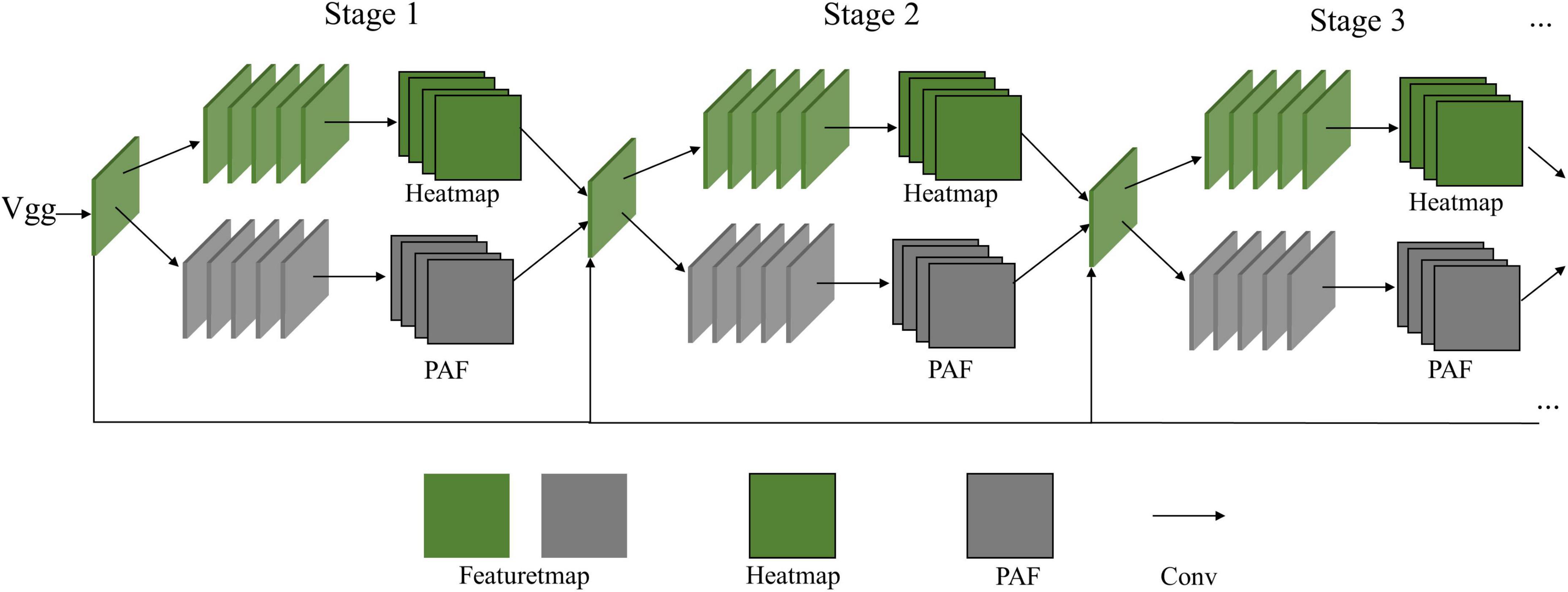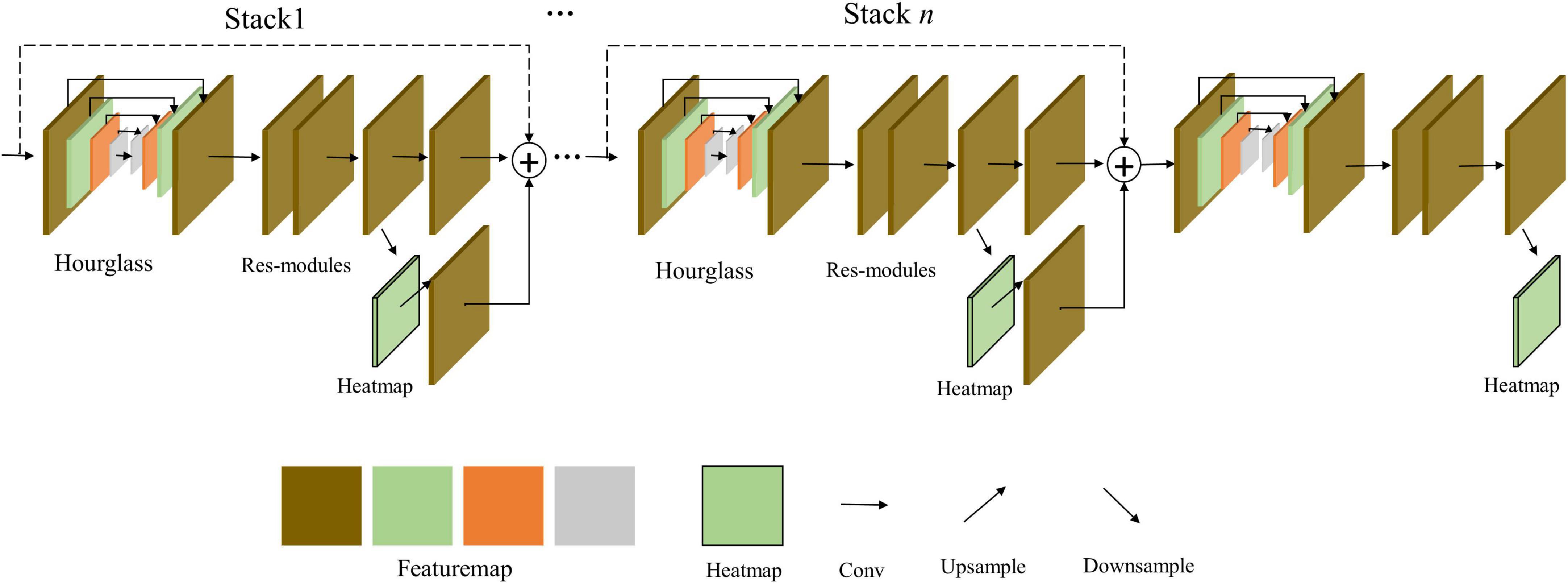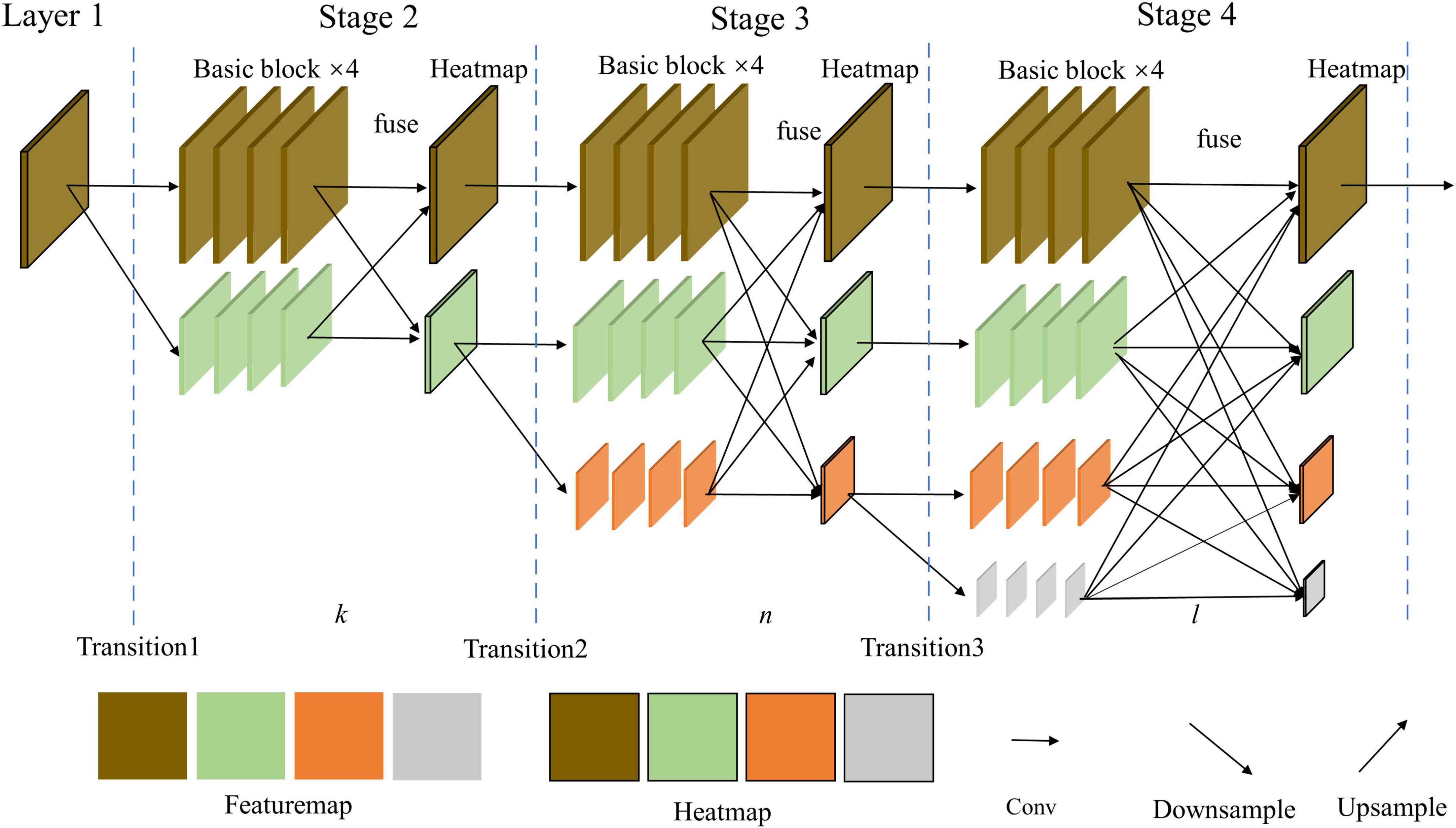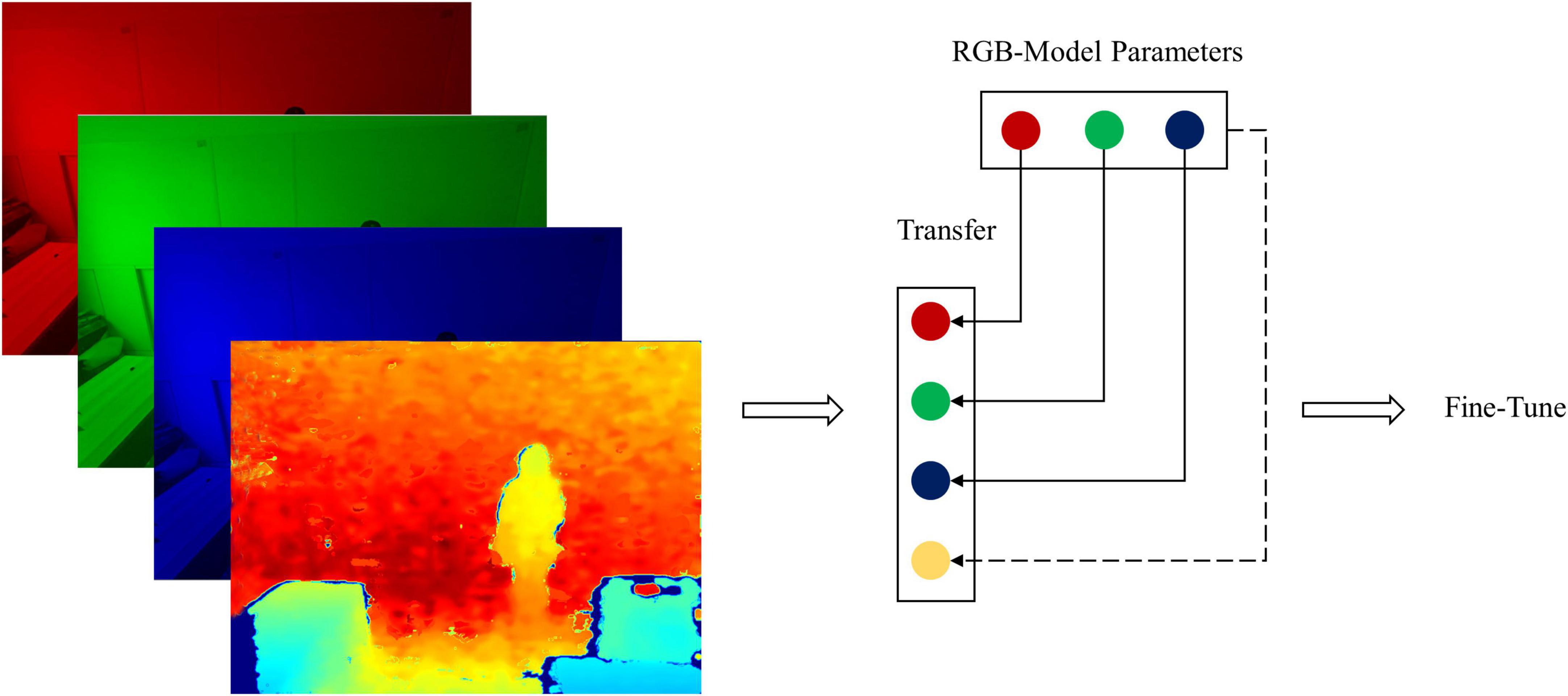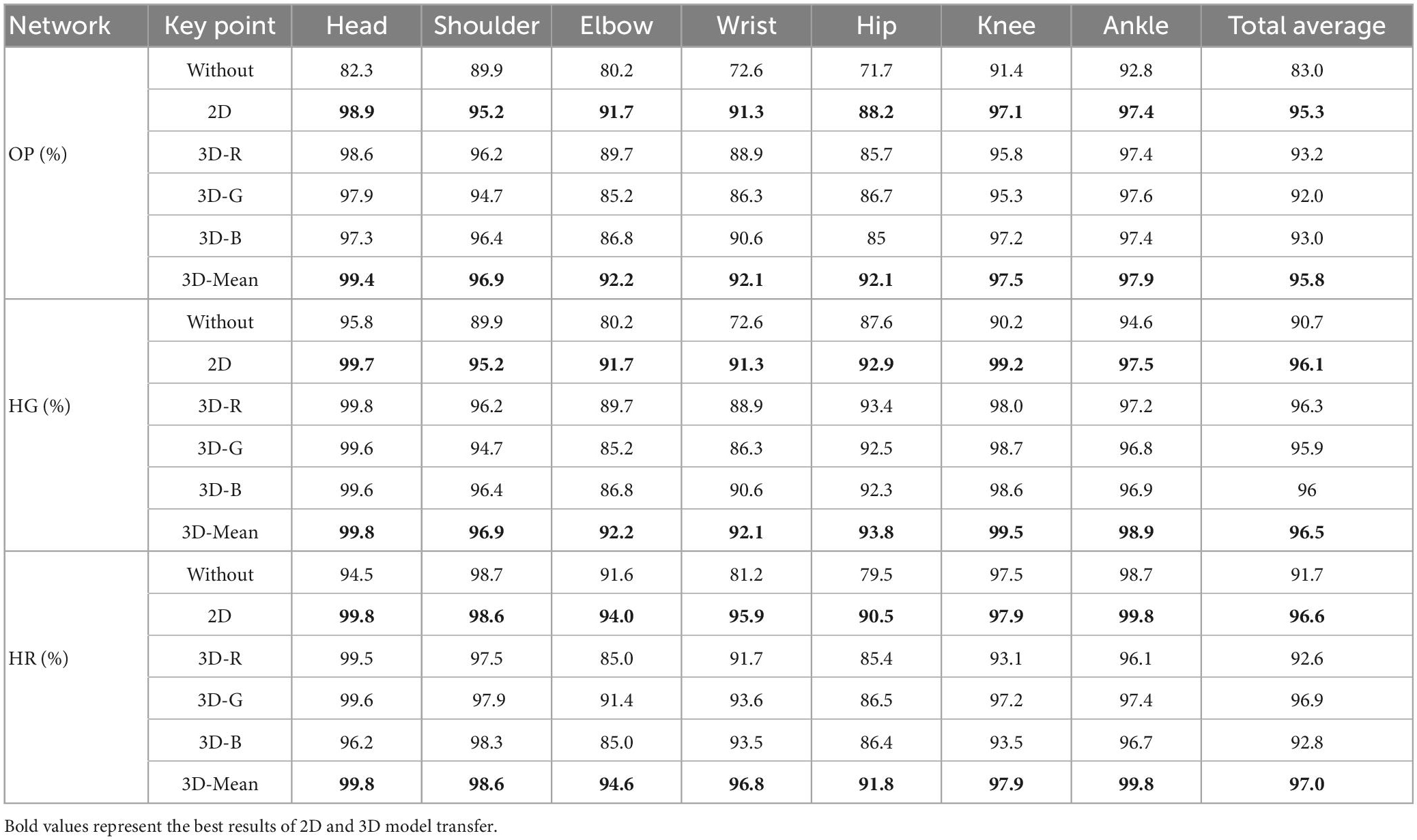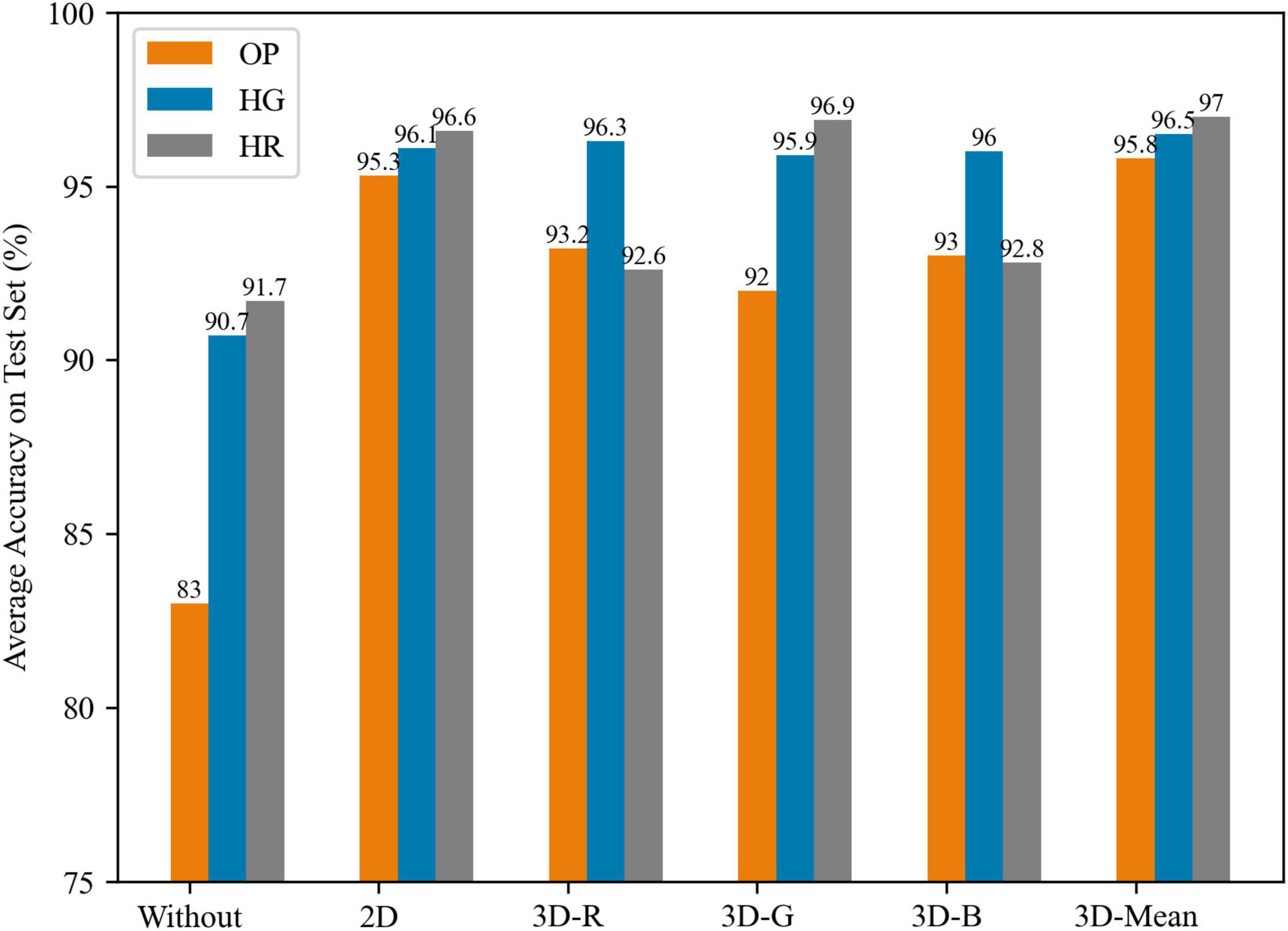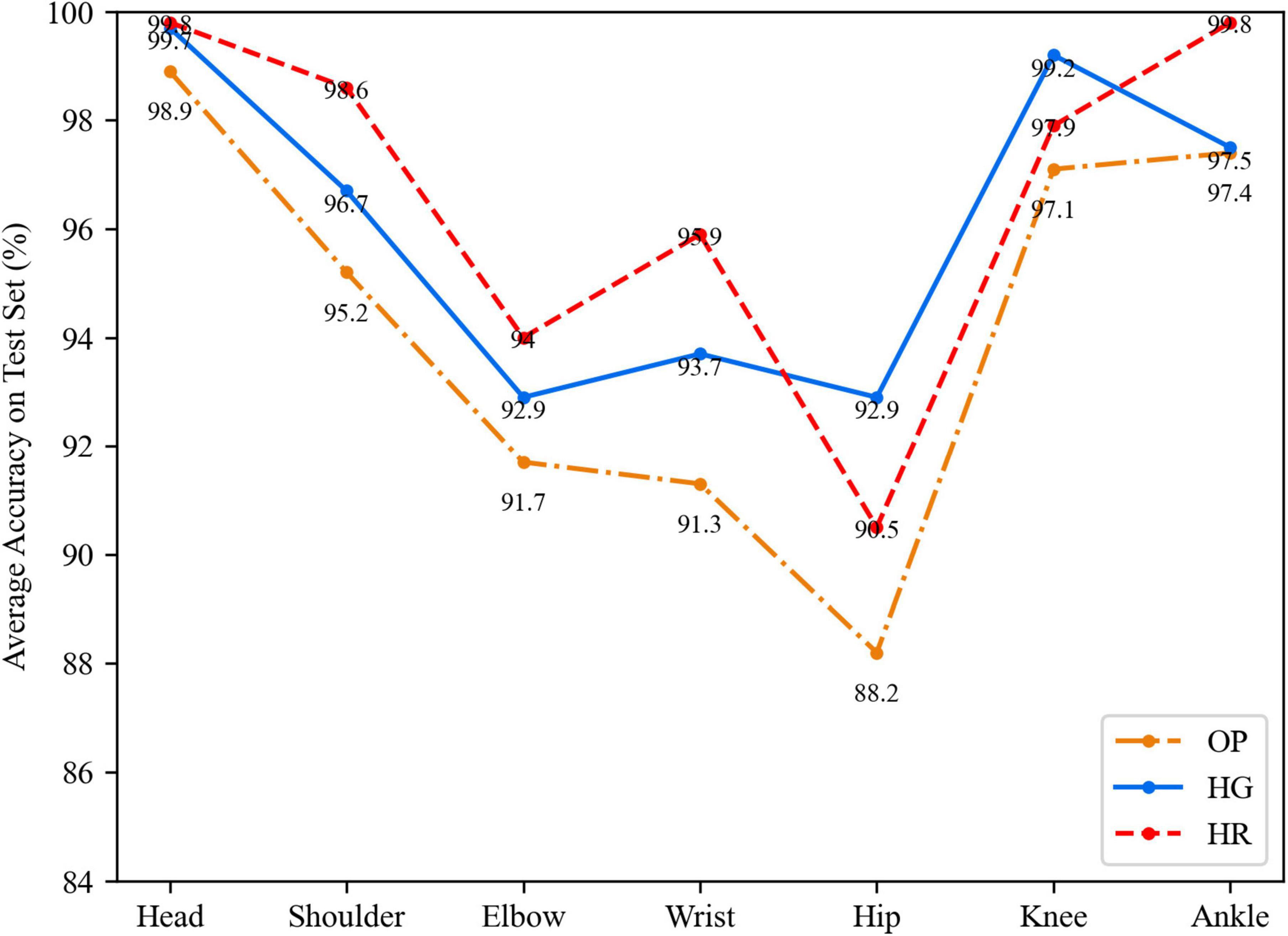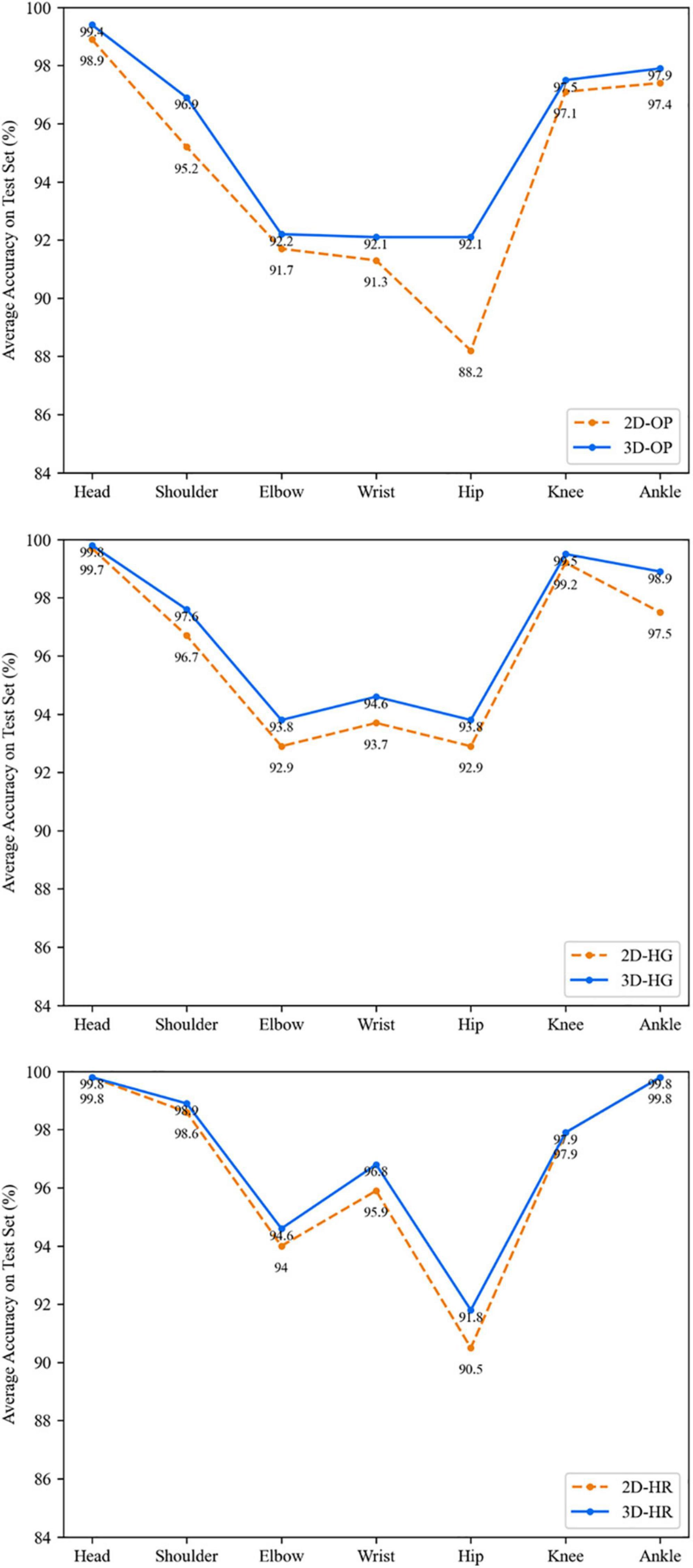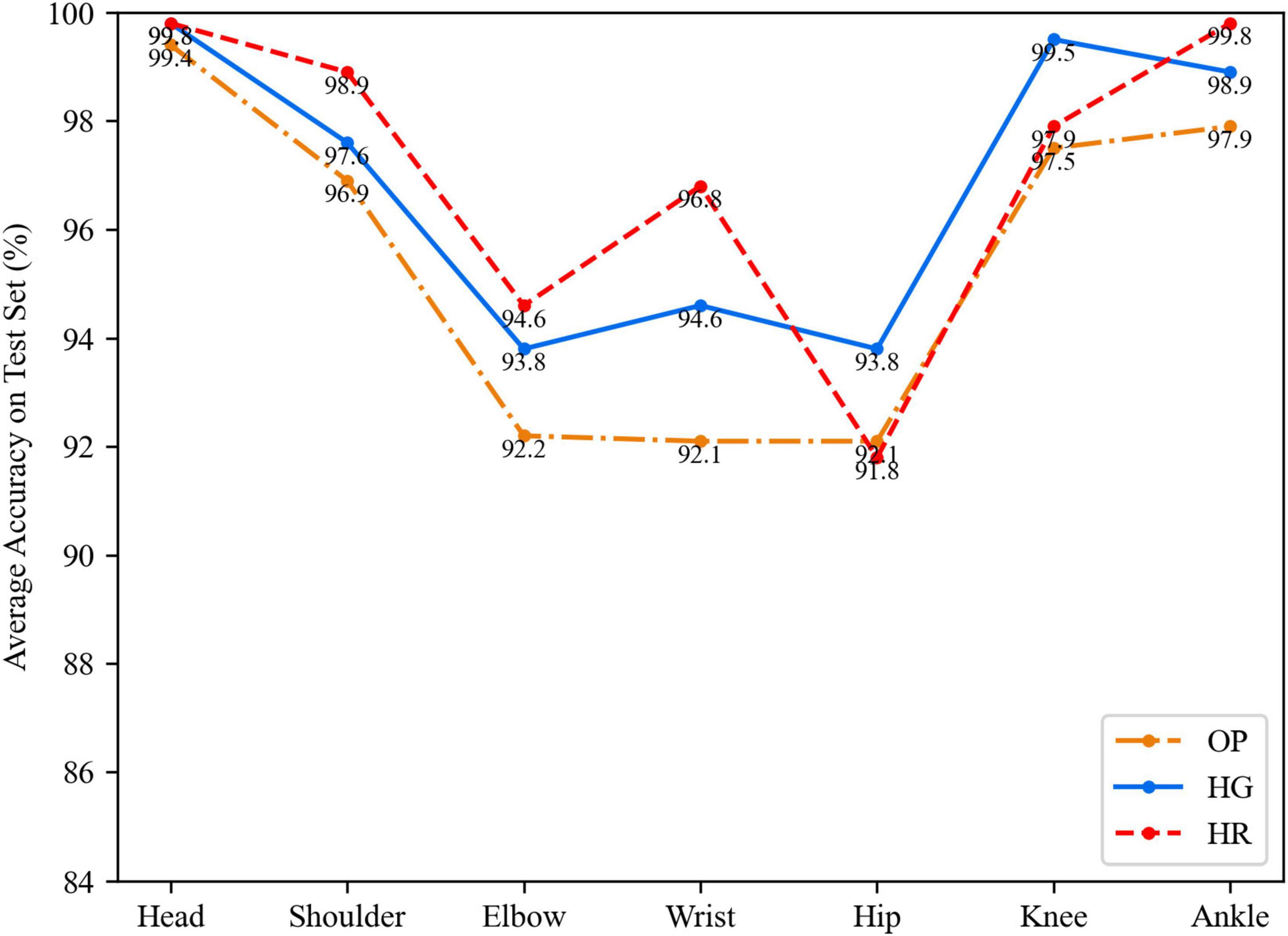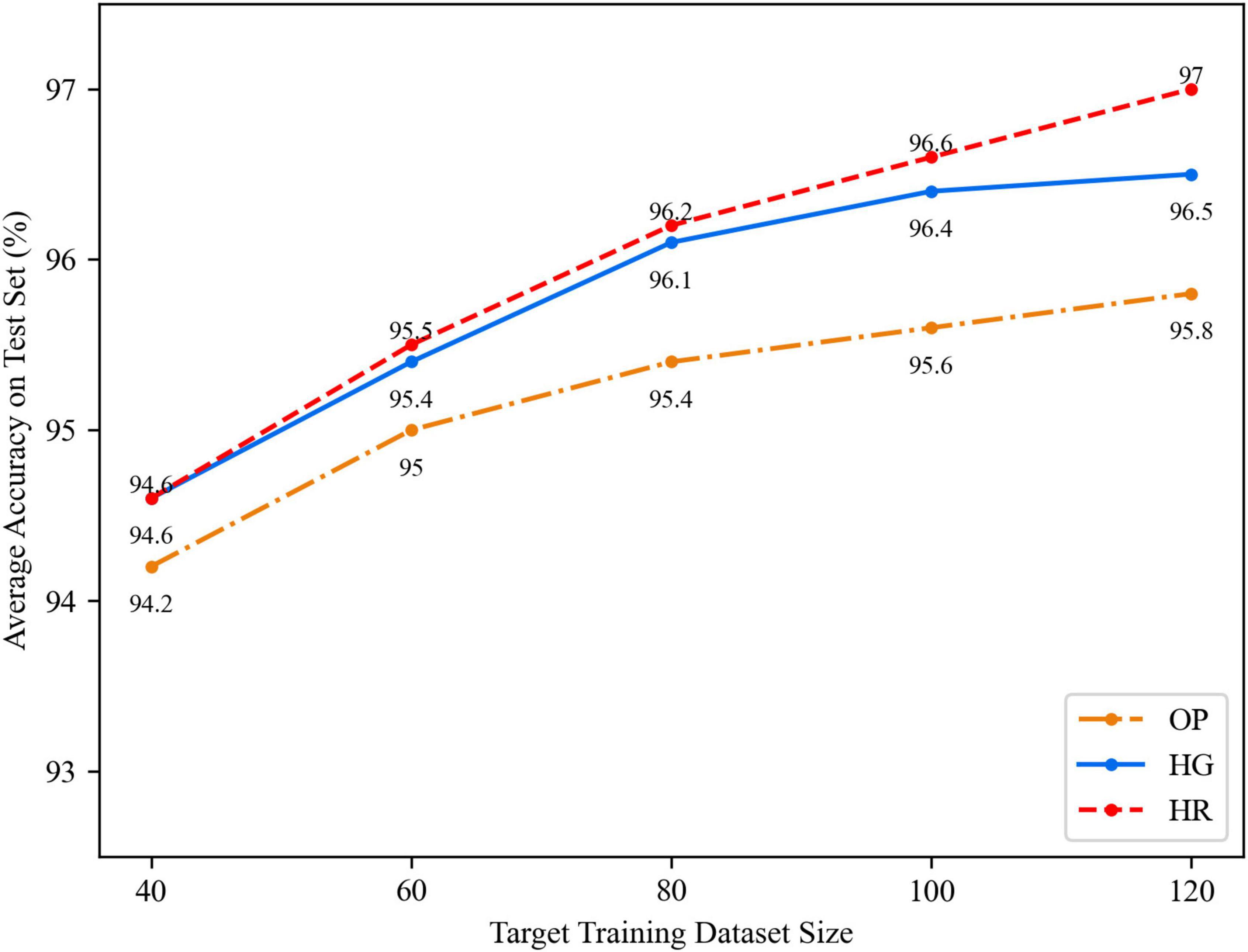- Faculty of Computer and Software Engineering, Huaiyin Institute of Technology, Huai’an, China
Introduction: Boxing as a sport is growing on Chinese campuses, resulting in a coaching shortage. The human pose estimation technology can be employed to estimate boxing poses and teach interns to relieve the shortage. Currently, 3D cameras can provide more depth information than 2D cameras. It can potentially improve the estimation. However, the input channels are inconsistent between 2D and 3D images, and there is a lack of detailed analysis about the key point location, which indicates the network design for improving the human pose estimation technology.
Method: Therefore, a model transfer with channel patching was implemented to solve the problems of channel inconsistency. The differences between the key points were analyzed. Three popular and highly structured 2D models of OpenPose (OP), stacked Hourglass (HG), and High Resolution (HR) networks were employed. Ways of reusing RGB channels were investigated to fill up the depth channel. Then, their performances were investigated to find out the limitations of each network structure.
Results and discussion: The results show that model transfer learning by the mean way of RGB channels patching the lacking channel can improve the average accuracies of pose key points from 1 to 20% than without transfer. 3D accuracies are 0.3 to 0.5% higher than 2D baselines. The stacked structure of the network shows better on hip and knee points than the parallel structure, although the parallel design shows much better on the residue points. As a result, the model transfer can practically fulfill boxing pose estimation from 2D to 3D.
1. Introduction
Boxing as a strenuous exercise is gradually being accepted by the general public in China. It has been promoted in many universities and has relevant professional courses (Xu, 2018; Li L., 2019; Li X., 2019; Logan et al., 2019). It can improve citizens’ and students’ physical and mental health (Tjønndal, 2019), and even enhances the self-protection abilities of women (Hu, 2018; Fuerniss and Jacobs, 2020). However, this results in a new problem of a coach shortage. Many researchers have tried to employ computer vision and robot technology to solve the shortage problem of coaches (Huang et al., 2019; Li et al., 2021; Lin et al., 2021, 2022; Mendez et al., 2022). The human pose estimation technology can predict boxing elements for better teaching, which can reduce reliance on coaches and increase entertainment in boxing training.
Currently, the 3D camera can provide more depth information than the traditional 2D RGB camera. This advantage can help in the advancement of many tasks of image processing, such as MRI images (Chen et al., 2019; Wu G. et al., 2022), robots (Song et al., 2020), 3D faces (Ning et al., 2020; Wu H. et al., 2022), and so on. 3D human pose estimation becomes a cutting-edge and interesting direction. Many researchers have attempted to reconstruct a 3D human pose estimation with 2D or 3D cameras. Since 2D estimation has been researched comprehensively and wholistically (Wang et al., 2021), it will be crucial to determine whether 2D estimation is compatible with 3D estimation. Adapting the existing 2D models to the application with 3D cameras and studying the advantages of these models is essential to boxing applications and promoting the technology of human pose estimation.
In the field of artificial intelligence, there are two main ways for human pose estimation: bottom-up and top-down (Xiao et al., 2018; Wang et al., 2021). For instance, the top-down method detects each person first, and then directly detects the key points of each person. It is a two-stage method. Most research is based on 2D imagery and shows brightness design and theoretical structures that achieve SOTA results, such as Hourglass (HG) models (Newell et al., 2016; Xiao et al., 2018; Hua et al., 2020; Xu and Takano, 2021), and High Resolution (HR) networks (Sun et al., 2019; Yu et al., 2021; Xu et al., 2022). In contrast, the bottom-up method recognizes the limbs of people at the beginning and groups these limbs for each person, such as in the OpenPose(OP) models (Cao et al., 2017) and Hourglass(HG) models (Nie et al., 2018). Three mainstream models of the OP, HG, and HR networks are suitable for our boxing application. However, the problem of channel inconsistency directly affects the transfer of a 2D model to a 3D image. The basic popular methods need to be investigated deeply, and it is important to reveal their performance differences in detail for better improvement.
Model transfer technology is employed to help improve the application of human pose estimation by transferring their models and parameters. The performance of estimation of boxing poses is evaluated on RGBD image. The main contributions of this paper are:
• The depth channel is patched by different strategies when data input is inconsistent, which illustrates that the negative transfer can happen in this step, and it implies that the machine learning method can further improve the strategy.
• A detailed analysis of human pose estimation technology reveals the advantages and disadvantages of mainstream models used in boxing pose estimation, indicating the new improving direction of this technology.
• The model transfer from 2D to 3D images is studied for boxing practice, which shows that 2D models can be compatible with the 3D inputs of 3D cameras.
In this manner, the three mainstream models of the OP, HG, and HR networks are studied. The following sections are mainly divided into three parts: (1) Related work. Research work about human pose estimation is presented and analyzed. The important structures of neural networks are discussed; (2) Method. The model-transfer technology is employed to study the transfer of relative top-down and bottom-up models, respectively. 2D inputs are transferred to adaptive 3D inputs. This section also describes different ways for model transfer. (3) Results and discussion. The previously mentioned approaches are carried out after model transfer, and 3D and 2D transfer results are analyzed in detail. Three basic methods are discussed to analyze their existing problems.
2. Related work
2.1. Top-down way
Newell et al. (2016) proposed the HG method, which expanded the ResNet structure to realize the extraction of pose information. To improve the joint position regression, Xiao et al. (2018) added a few deconvolutional layers over the last convolution stage in the ResNet, which generated heatmaps from deep and low-resolution features. Considering Xiao’s architecture, Moon et al. (2019) designed a PoseFix network to refine the estimation, which applies to a model-agnostic pose refinement method. Hua et al. (2020) took a multipath affinage way to improve HG networks. Furthermore, Graph stacked HG network was developed by Xu and Takano (2021). It has an HG shape consisting of a chain of convolution and up-convolution layers followed by a regression part for generating a 3D pose. However, this estimation is based on 2D image inputs.
Chen et al. (2018) proposed a cascaded pyramid network (CPN) for human pose estimation. It has GloableNet and RefineNet as two parts, and each layer was parallel to exchange information. But for a better exchange of information between different scale features, Sun et al. (2019) further proposed a high-resolution (HR) network method for information exchange at the base of a huge pyramid structure. HigherHRNet was proposed (Cheng et al., 2020) to use the high-resolution feature pyramid for prediction by a 1 × 1 convolution to heatmaps based on the HR network. It can solve the scale variation challenge in bottom-up multi-person pose estimation. To reduce the parameters and improve speed, Yu et al. (2021) refined the HR network called the Lite-HR network, which applies shuffle blocks to the HR network. The accuracy got a slight drop. Xu et al. (2022) applied the transformer model to human pose estimation. This simple structure can be the backbone to extract features for the HR network. This improvement is based on longer training, and it has challenges for patch embedding when there is less information around key points.
2.2. Bottom-up way
The OP network model (Cao et al., 2017) based on the affinity field could simultaneously locate multiple people and get wild applications (Nakai et al., 2018; Viswakumar et al., 2019; Chen et al., 2020; Nakano et al., 2020). The key points are detected in each joint class and grouped into limbs between each joint point. With a part association field (PAF) restriction, the limbs are gathered at a minimum cost. Nie et al. (2018) proposed a pose partition network (PPN) to detect joints and regression for multi-persons, which is based on the HG network. Since a PAF was used to associate body parts with each other, a part intensity field (PIF) was proposed to localize body parts (Kreiss et al., 2019) and help form full human poses. Osokin (2018) proposed a lightweight OP network, which only remained in one refinement stage and replaced the VGG network with the MobileNet in the backbone. Wu et al. (2021) proposed a rapid OP network for astronaut operation attitude detection. They changed the original two-branch structure to a single-branch structure, which improved the calculation speed. Geng et al. (2021) proposed disentangled key point regression (DEKR), which uses a multi-branch structure for separate regressions to get the key points in the bottom-up paradigm. For multi-person pose estimation, Jin et al. (2020) reformulated the task of multi-person pose estimation as a graph-clustering problem. The OP networks rely on the backbone network for feature extraction.
According to the above analysis, studies based on the OP, HG, and HR networks are very extensive, and the HR and HG networks can be used both in the top-down and bottom-up way. The study of these three methods can be better at comprehensively finding problems in our boxing sport application.
3. Materials and methods
3.1. Device and dataset
The image data collecting tool was a 3D Intel Realsense D455 camera with a 640 × 480 resolution. It was placed approximately 185 cm above the ground, with a depression angle of 10 degrees around. RGBD data was collected in various indoor environments such as classrooms and research labs. Five basic boxing poses, including punch, swing, hook, backward, and side slide were recorded in left and right ways. More than 100 students contributed to the collection. After data cleaning, 280 images were selected to form a dataset for this research. The dataset was randomly divided into three parts: a training set (120 images), a validation set (40 images), and a test set (120 images). These three sets didn’t have the same person.
3.2. Model transfer learning
After testing, three SOTA models of the OP, HG, and HR networks were studied. They were transferred as source models since these three basic models have been researched extensively and achieve each best performance. All the models are 2D inputs. The boxing pose estimation was the target learning task. The 640 × 480 boxing image is estimated directly because three models are studied under the same size of the input, feature maps, and heatmaps.
3.2.1. OP network model
There are two primary parallel branches in the OP network. One branch is trained to predict the heatmap of human pose key points, and the other branch is trained to predict the PAF that can help organize the components of body limbs in a bottom-up way. The model repeats the basic branches several times as stages as displayed in Figure 1. This design can be easy for multi-person estimation as it estimates every person’s key point at one computation, but the heatmap branch is simple for extracting complex features and structures since it only depends on convolution layers.
3.2.2. Stacked HG network model
In Figure 2, the HG network is inspired by the pyramid structure to deal with the local and global context. In each stack, there is a pyramid structure integrated inside, and the heatmaps are generated to predict key points, and each stack is repeated to group a complex network. It can be seen that the learning ability is improved by its pyramid structure. The stack is very similar to the OP stage, so it can be used in both top-down and bottom-up ways, but there is less information exchange for each stack. This may cause limited learning in the local context.
3.2.3. HR network model
As shown in Figure 3, the HR network has an inverse pyramid parallel structure compared to the HG network. It can be seen that there are 4 parallel channels in different image scales, which can get local and global information. Besides, this separates 3 or 4 stages to make the model better exchange information between different scale feature maps. The parallel branches in each stage are usually repeated a few times to make a better extraction. Therefore, features can be combined in multiple ways. Compared with the above two networks, the HR network in each stage doesn’t keep the same size, which means it may have less learning ability for symmetry structures.
The above three source models (Model2D) were transferred as shown in Figure 4. The input data in a source learning task can be described as, n is the input data dimension, and k is the instance number. In the target learning task, the input data is, and the instance number m is far less than k. Therefore, the posterior distribution of the source domain PS(y|xn) needs to change to the target domain posterior distribution PT(y|xn + 1). The fine-tuning method can be used to adapt the source posterior distribution to the target domain. To solve the problem of lacking depth channel in source models, an additional channel of the parameter was patched based on RGB channels as in formula (1):
Where the channel parameters can be chosen from R, G, and B channels or the mean combination of these three channels. When transferring parameters from source models, the different channel effects should be examined, and the best way to improve the depth channel effects on predicting posture points should be determined. Boxing pose data were used to fine-tune the models to generate new models.
4. Results and discussion
The performance of transferred models was studied in four ways: (1) the average accuracy was obtained about boxing pose key point positions, and the corresponding accuracy of each model after the transfer of different channels was compared to baselines of 2D transfer; (2) the impact of fine-tuning instance amount on model transfer improvement; (3) the Flops and parameter number of each model were shown for evaluating model complex, and average cost times of models per image were compared; (4) a direct comparison of the pose estimation of boxing basic actions among different models, along with pose estimation display.
4.1. The average prediction accuracies of key points
There are seven distinct critical points for estimating human poses including the head, shoulder, elbow, wrist, hip, knee, and ankle. To keep the comparison of points consistent, the neck point of OP does not show here. Table 1 shows the average accuracy of 10 times repeat on each point recorded without fine-tuning, 2D transfer with fine-tuning, and 3D transfer with a different kind of channel. The source models of the OP, HR, and HG networks were pretrained and released publicly by their developers.
Table 1 shows that three models are listed in each column, and in each row, the average accuracy of each key point is compared. The 2D rows can be chosen as baselines for 3D transfer. In 3D transfers, the R, G, and B channels were examined, respectively. In addition, the mean of the three channels was also examined.
Each network in Table 1 includes 6 different methods of fine-tuning; 2D, and 3D are displayed in Figure 5. There are 6 groups for three networks. The accuracies of the first group are lower than those of the second group after finetuning in 2D transfer, and the HR network achieves the highest average accuracy of 96.6%. The HG network achieves a similar performance at 96.1%, while the OP network achieves 95.3%, which is increased by 12.3%. After fine-tuning, both networks perform slightly better than the OP network. When in 3D transfer, the third to sixth groups in Figure 5 show different channel parameters that are chosen or combined to patch the lacking depth channel. The R and B channels affect the OP and HG networks the most, whereas the G channel affects the HR network the most, and the R and B channels even can cause a negative transfer on the HR network (from 96.6 to 92.8%). The mean strategy of R, G, and B channels get the best estimation than in a single one-channel way. This situation shows that the three networks learn different patterns in different channels. The OP and HG network extracts features from three channels equally, while the HR network gets features from the G channel, which is highly related to depth information. Features from B and R channels are less related to depth information.
Figure 6 shows the detailed results of 2D. The HR network can get the best estimation on the head, shoulder, elbow, wrist, and ankle points. However, the HG network estimates hip and knee points better than the HG network. Both the OP and HR networks are worse in hip point estimation. This phenomenon might be caused by the lower learning ability of the OP network and the lower symmetric ability of the HR network than the HG network since these two kinds of points have fewer texture features in the image. The HG model has a lower feature extraction than the HR network.
Finally, compared with the second group of 2D transfer, the mean 3D group average accuracies are all higher than that of the 2D group as shown in Figure 7. The OP network is improved by 3.3% on hip points, which is higher than other networks. This may be caused because of the previous imbalance training by authors. In Figure 8, the 3D transfer also shows a similar result as the 2D transfer. The HR network performs better on the head, shoulder, elbow, wrist, and ankle points, but the HG network performs better on hip and knee points. It means that the HR network has a deficiency on the hip and knee points when there is less texture information around. The depth channel shows less help to the estimation. This may be the bottleneck of transfer learning when lacking depth training data.
4.2. The fine-tuning effect of different training data set size
The average accuracy curves of the OP, HR, and HG networks are drawn under the different training dataset sizes from 40 to 120, which increases by 20 each step.
As shown in Figure 9, the horizontal axis indicates the amount of training dataset size. The vertical axis indicates the average accuracy on the test set. The results show the HR model still performs better than others. But when the data size is small, from 40 to 80, it is almost the same as the HG network. With an increase in the training dataset size, the HR network becomes better than the HG network. It means the HR network might get much better results when the dataset size becomes large. The OP network performance increases a bit slower than the other two networks and it tends to be plain.
4.3. The FLOPs and average cost time
The Floating-Point Operations (FLOPs) and average cost time on the test set are shown in Table 2. The same resolution images were fed into the three networks. The parameter number of each kind of network is displayed. It can be seen that the numbers of HG and OP’s parameters and average cost times are almost equal, and they are both nearly twice that of HR. As the parameters are reduced by half, the GFLOPs can be reduced largely.
4.4. Comparison of the pose estimation on boxing basic movements
Five postures of punch, swing, hook, backward, and side sliding are estimated in both left and right ways as displayed in Figure 10. The figure shows two different scenes, and the results are listed in a sequence of without fine-tuning, after the 3D transfer, and ground truth. It also displays the results of the OP, HG, and HR networks, respectively.
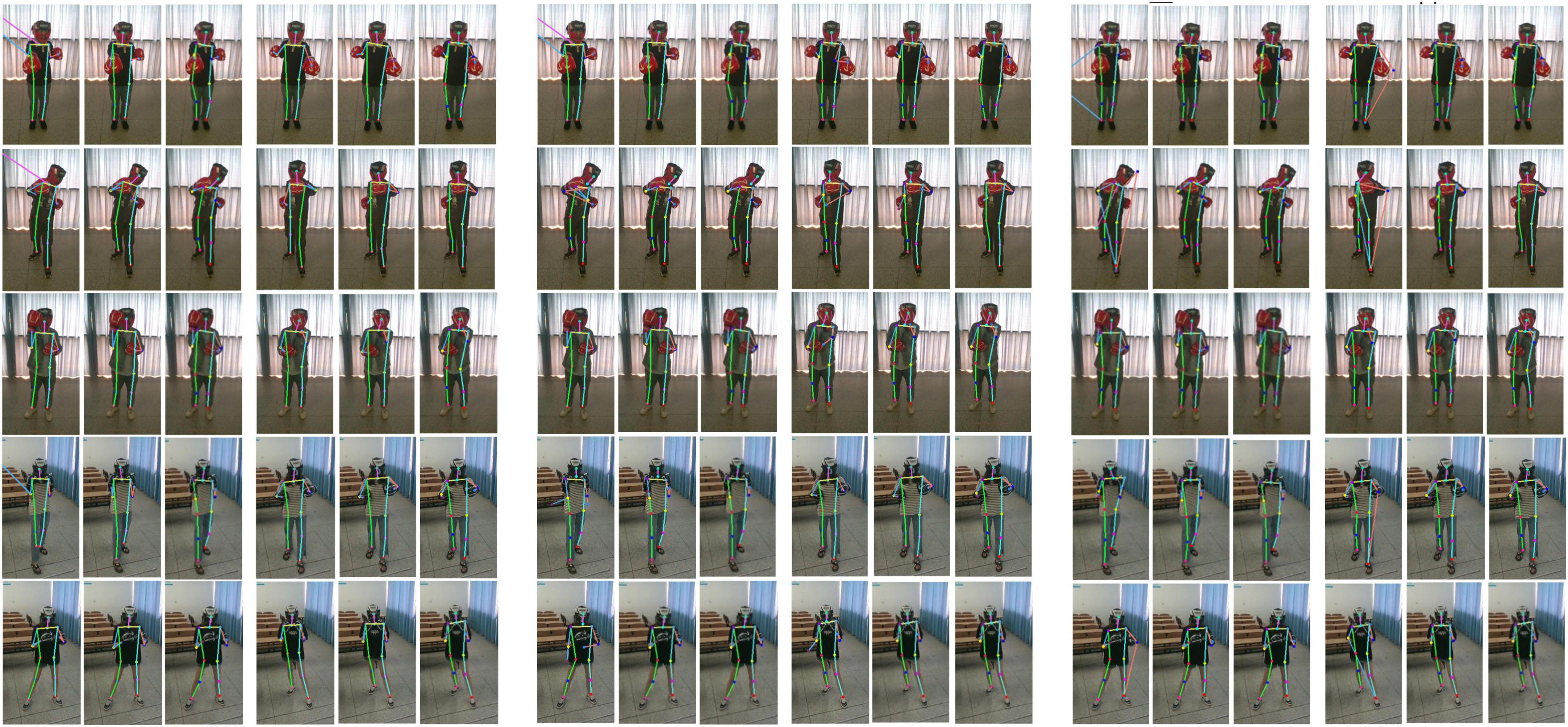
Figure 10. The pose estimation of the OP network (left), HG network (middle), and HR network (right) after model transfer.
In the first column of each figure, there are many errors in five poses. The head and wrist points are wrongly located. The estimation results are littered randomly since the left and right results of both the OP and HG networks have a big difference. This phenomenon may be caused by the background. The edge of curtains or chairs might be like the human edge. The HR network’s left and right results are more symmetric than other methods. Besides, the obscuring from the boxing helmet and the camera’s inconsistent view also result in locating the wrong place such as the ankle, hip, and elbow.
The second columns of the left and right poses show the estimations are improved. It is much closer to the third column of ground truth. So, fine-tuning can correct the errors from background interference, obscuring, and view inconsistency. In addition, it can be seen that the HR network’s estimation of hip and knee joints is compelled in a line, which is quite different from the HG’s estimation. That means the HR network can be further improved.
5. Conclusion
With the popularization of boxing in China, the lack of coaches and amusement impedes the promotion of this sport. The research on intelligent humanoid boxing robots becomes hotter, and the problem of insufficient coaches can be solved. Through the application of human pose estimation technology, the actions of boxing athletes can be analyzed, guided, and taught. The inconsistent inputs between the current image-based 2D human pose estimation technology and the 3D data of RGBD prevent our study because of the shortage of boxing data. The model transfer method is adopted to improve the technology application by patching the lack of channel. Three SOTA models of this technology were studied and transferred for experiments. Different strategies of transfer were examined to patch the lack of depth channel. The results show that the mean combination of RGB channel parameters is suitable to patch the depth channel. This strategy can improve models’ estimation performance stability. In addition, model transfer learning can efficiently reduce the dependence on collecting new data. The three SOTA models of the OP, HR, and HG networks exhibit competitive ability, and each model achieves a better performance after a mixture of depth channel information. Based on this research, the technical problems existing in the application of boxing can be revealed further, such as the HR network needing to improve the estimation of hip and knee joints and integrating these basic models into a small platform for the different kinds of applications. A machine learning method to optimize this combination can be researched further. Nonetheless, transfer learning with the channel patching method has been successfully studied for boxing pose estimation, and the 2D model performance can be improved by a 3D camera. Data can be collected to enhance the model’s application.
Data availability statement
The original contributions presented in this study are included in the article/supplementary material, further inquiries can be directed to the corresponding author.
Author contributions
JL supervised the projects, proposed the research plan for this article, and dealt with the revision of the algorithm. XC supervised the analysis of models and analyzed the theory for networks. XX and TH were in charge of data collection and analysis, coding, article writing, translation, and discussion. WW, SX, and CL implemented the experiments, analysis of results, and code revising. All authors contributed to the article and approved the submitted version.
Funding
This work is supported by the program of Entrepreneurship and Innovation Ph.D. in Jiangsu Province (JSSCBS20211175), the Natural Science Foundation of the Jiangsu Higher Education Institutions of China (21KJB520002), and the School Ph.D. Talent Funding (Z301B2055).
Acknowledgments
Thanks to the students who participated in data collection and patiently completed the boxing postures.
Conflict of interest
The authors declare that the research was conducted in the absence of any commercial or financial relationships that could be construed as a potential conflict of interest.
Publisher’s note
All claims expressed in this article are solely those of the authors and do not necessarily represent those of their affiliated organizations, or those of the publisher, the editors and the reviewers. Any product that may be evaluated in this article, or claim that may be made by its manufacturer, is not guaranteed or endorsed by the publisher.
References
Cao, Z., Simon, T., Wei, S.-E., and Sheikh, Y. (2017). “Realtime multi-person 2d pose estimation using part affinity fields,” in Proceedings of the IEEE conference on computer vision and pattern recognition, Honolulu, HI, 7291–7299. doi: 10.1109/CVPR.2017.143
Chen, S., Ma, K., and Zheng, Y. (2019). Med3d: Transfer learning for 3d medical image analysis. arXiv [Preprint]. arXiv:1904.00625.
Chen, W., Jiang, Z., Guo, H., and Ni, X. (2020). Fall detection based on key points of human-skeleton using OpenPose. Symmetry 12:744. doi: 10.3390/sym12050744
Chen, Y., Wang, Z., Peng, Y., Zhang, Z., Yu, G., and Sun, J. (2018). “Cascaded pyramid network for multi-person pose estimation,” in Proceedings of the IEEE conference on computer vision and pattern recognition, Salt Lake City, UT, 7103–7112. doi: 10.1109/CVPR.2018.00742
Cheng, B., Xiao, B., Wang, J., Shi, H., Huang, T. S., and Zhang, L. (2020). “Higherhrnet: Scale-aware representation learning for bottom-up human pose estimation,” in Proceedings of the IEEE conference on computer vision and pattern recognition, Seattle, WA, 5386–5395. doi: 10.1109/CVPR42600.2020.00543
Fuerniss, K., and Jacobs, J. M. (2020). We are strong: Strategies for fostering body empowerment in a boxing program for middle school girls. J. Sport Psychol. Act. 11, 45–56. doi: 10.1080/21520704.2019.1693456
Geng, Z., Sun, K., Xiao, B., Zhang, Z., and Wang, J. (2021). “Bottom-up human pose estimation via disentangled keypoint regression,” in Proceedings of the IEEE conference on computer vision and pattern recognition, Manhattan, NY, 14676–14686. doi: 10.1109/CVPR46437.2021.01444
Hu, X. (2018). Analysis on the development status of professional boxing in China. Adv. Phys. Sci. 3, 91–95. doi: 10.12677/APS.2018.63016
Hua, G., Li, L., and Liu, S. (2020). Multipath affinage stacked-hourglass networks for human pose estimation. Front. Comput. Sci. 14:144701. doi: 10.1007/s11704-019-8266-2
Huang, X., Wang, G., Ren, P., and Hu, Y. (2019). Study on the dynamic system of the desktop boxing robot. J. Mach. Des. 36, 32–36.
Jin, S., Liu, W., Xie, E., Wang, W., Qian, C., Ouyang, W., et al. (2020). “Differentiable hierarchical graph grouping for multi-person pose estimation,” in Proceedings of the European conference on computer vision, Online, 718–734. doi: 10.1007/978-3-030-58571-6_42
Kreiss, S., Bertoni, L., and Alahi, A. (2019). “Pifpaf: Composite fields for human pose estimation,” in Proceedings of the IEEE conference on computer vision and pattern recognition, Manhattan, NY, 11977–11986. doi: 10.1109/CVPR.2019.01225
Li, L. (2019). Research on problems and countermeasures in the development of boxing into the campus. Box. Fight 4:134.
Li, X. (2019). Feasibility study on opening boxing in physical education course of primary and secondary schools. Wushu Stud. 4, 70–72.
Li, Y., Wang, P., Fang, Y., and Wang, D. (2021). Design and implementation of a boxing robot based on fuzzy control. J. Phys. 1303:012065. doi: 10.1088/1742-6596/1303/1/012065
Lin, J. C., Gu, Z., Amir, A. M., Chen, X., Ashim, K., and Shi, K. (2021). “A fast humanoid robot arm for boxing based on servo motors,” in Proceedings of the IEEE international Conference on high-performance big data and intelligent systems, Macau, 252–255. doi: 10.1109/HPBDIS53214.2021.9658471
Lin, J. C., Xie, X., Wu, W., Xu, S., Liu, C., and Hudoyberdi, T. (2022). “Human pose estimation for boxing based on model transfer learning,” in Proceedings of the IEEE international conference on high-performance big data and intelligent systems, Tianjin, 333–336. doi: 10.1109/HDIS56859.2022.9991696
Logan, K., Cuff, S., LaBella, C. R., Brooks, M. A., Canty, G., Diamond, A. B., et al. (2019). Organized sports for children, preadolescents, and adolescents. Pediatrics 143:e20190997. doi: 10.1542/peds.2019-0997
Mendez, S. L. A., Ng, H. Y., Lim, Z. Y., Lu, Y.-J., and Han, P.-H. (2022). “MovableBag: Substitutional robot for enhancing immersive boxing training with encountered-type haptic,” in Proceedings of the SIGGRAPH Asia 2022 XR, (New York, NY: ACM), 1–2. doi: 10.1145/3550472.3558406
Moon, G., Chang, J. Y., and Lee, K. M. (2019). “Posefix: Model-agnostic general human pose refinement network,” in Proceedings of the IEEE conference on computer vision and pattern recognition, Long Beach, CA, 7773–7781. doi: 10.1109/CVPR.2019.00796
Nakai, M., Tsunoda, Y., Hayashi, H., and Murakoshi, H. (2018). “Prediction of basketball free throw shooting by OpenPose,” in Proceedings of the JSAI international symposium on artificial intelligence, New York, NY, 435–446. doi: 10.1007/978-3-030-31605-1_31
Nakano, N., Sakura, T., Ueda, K., Omura, L., Kimura, A., Iino, Y., et al. (2020). Evaluation of 3D markerless motion capture accuracy using OpenPose with multiple video cameras. Front. Sports Act. Living 2:50. doi: 10.3389/fspor.2020.00050
Newell, A., Yang, K., and Deng, J. (2016). “Stacked hourglass networks for human pose estimation,” in Proceedings of the European conference on computer vision, (Cham: Springer), 483–499. doi: 10.1007/978-3-319-46484-8_29
Nie, X., Feng, J., Xing, J., and Yan, S. (2018). “Pose partition networks for multi-person pose estimation,” in Proceedings of the European conference on computer vision, Munich, 684–699. doi: 10.1007/978-3-030-01228-1_42
Ning, X., Duan, P., Li, W., and Zhang, S. (2020). Real-time 3D face alignment using an encoder-decoder network with an efficient deconvolution layer. IEEE Signal Process. Lett. 27, 1944–1948. doi: 10.1109/LSP.2020.3032277
Osokin, D. (2018). Real-time 2d multi-person pose estimation on CPU: Lightweight OpenPose. arXiv [Preprint]. arXiv:1811.12004. doi: 10.5220/0007555407440748
Song, S., Zeng, A., Lee, J., and Funkhouser, T. (2020). Grasping in the wild: Learning 6dof closed-loop grasping from low-cost demonstrations. IEEE Robot. Autom. Lett. 5, 4978–4985. doi: 10.1109/LRA.2020.3004787
Sun, K., Xiao, B., Liu, D., and Wang, J. (2019). “Deep high-resolution representation learning for human pose estimation,” in Proceedings of the IEEE conference on computer vision and pattern recognition, Long Beach, CA, 5693–5703. doi: 10.1109/CVPR.2019.00584
Tjønndal, A. (2019). “Girls are not made of glass!”: Barriers experienced by women in Norwegian olympic boxing. Sociol. Sport J. 36, 87–96. doi: 10.1123/ssj.2017-0130
Viswakumar, A., Rajagopalan, V., Ray, T., and Parimi, C. (2019). “Human gait analysis using OpenPose,” in Proceedings of the IEEE international conference on image information processing, Shimla, 310–314. doi: 10.1109/ICIIP47207.2019.8985781
Wang, J., Tan, S., Zhen, X., Xu, S., Zheng, F., He, Z., et al. (2021). Deep 3D human pose estimation: A review. Comput. Vis. Image Understand. 210:103225. doi: 10.1016/j.cviu.2021.103225
Wu, E. Q., Tang, Z. R., Xiong, P., Wei, C. F., Song, A., and Zhu, L. M. (2021). ROpenPose: A rapider openpose model for astronaut operation attitude detection. IEEE Trans. Ind. Electron. 69, 1043–1052. doi: 10.1109/TIE.2020.3048285
Wu, G., He, F., Zhou, Y., Jing, Y., Ning, X., Wang, C., et al. (2022). ACGAN: Age-compensated makeup transfer based on homologous continuity generative adversarial network model. IET Comput. Vis. 1–12. doi: 10.1049/cvi2.12138
Wu, H., Luo, J., Lu, X., and Zeng, Y. (2022). 3D transfer learning network for classification of Alzheimer’s disease with MRI. Int. J. Mach. Learn. Cybern. 13, 1997–2011. doi: 10.1007/s13042-021-01501-7
Xiao, B., Wu, H., and Wei, Y. (2018). “Simple baselines for human pose estimation and tracking,” in Proceedings of the European conference on computer vision, Munich, 466–481. doi: 10.1007/978-3-030-01231-1_29
Xu, Q. (2018). Exploration on the construction of boxing culture in Chinese colleges and universities. Sports World 9, 105–106.
Xu, T., and Takano, W. (2021). “Graph stacked hourglass networks for 3d human pose estimation,” in Proceedings of the IEEE conference on computer vision and pattern recognition, Manhattan, NY, 16105–16114. doi: 10.1109/CVPR46437.2021.01584
Xu, Y., Zhang, J., Zhang, Q., and Tao, D. (2022). ViTPose: Simple vision transformer baselines for human pose estimation. arXiv [Preprint]. arXiv:2204.12484.
Keywords: boxing robot, computer vision, human pose estimation, 3D model transfer, negative transfer
Citation: Lin J, Xie X, Wu W, Xu S, Liu C, Hudoyberdi T and Chen X (2023) Model transfer from 2D to 3D study for boxing pose estimation. Front. Neurorobot. 17:1148545. doi: 10.3389/fnbot.2023.1148545
Received: 20 January 2023; Accepted: 13 February 2023;
Published: 20 March 2023.
Edited by:
Xin Ning, Institute of Semiconductors (CAS), ChinaReviewed by:
Alwin Poulose, Indian Institute of Science Education and Research, IndiaS. Khan, Kohat University of Science and Technology, Pakistan
A. Jorge Morais, Universidade Aberta, Portugal
Copyright © 2023 Lin, Xie, Wu, Xu, Liu, Hudoyberdi and Chen. This is an open-access article distributed under the terms of the Creative Commons Attribution License (CC BY). The use, distribution or reproduction in other forums is permitted, provided the original author(s) and the copyright owner(s) are credited and that the original publication in this journal is cited, in accordance with accepted academic practice. No use, distribution or reproduction is permitted which does not comply with these terms.
*Correspondence: Xiaobing Chen, Y2hlbnhpYW9iaW5nQGh5aXQuZWR1LmNu
 Jianchu Lin
Jianchu Lin Xiaolong Xie
Xiaolong Xie Wangping Wu
Wangping Wu